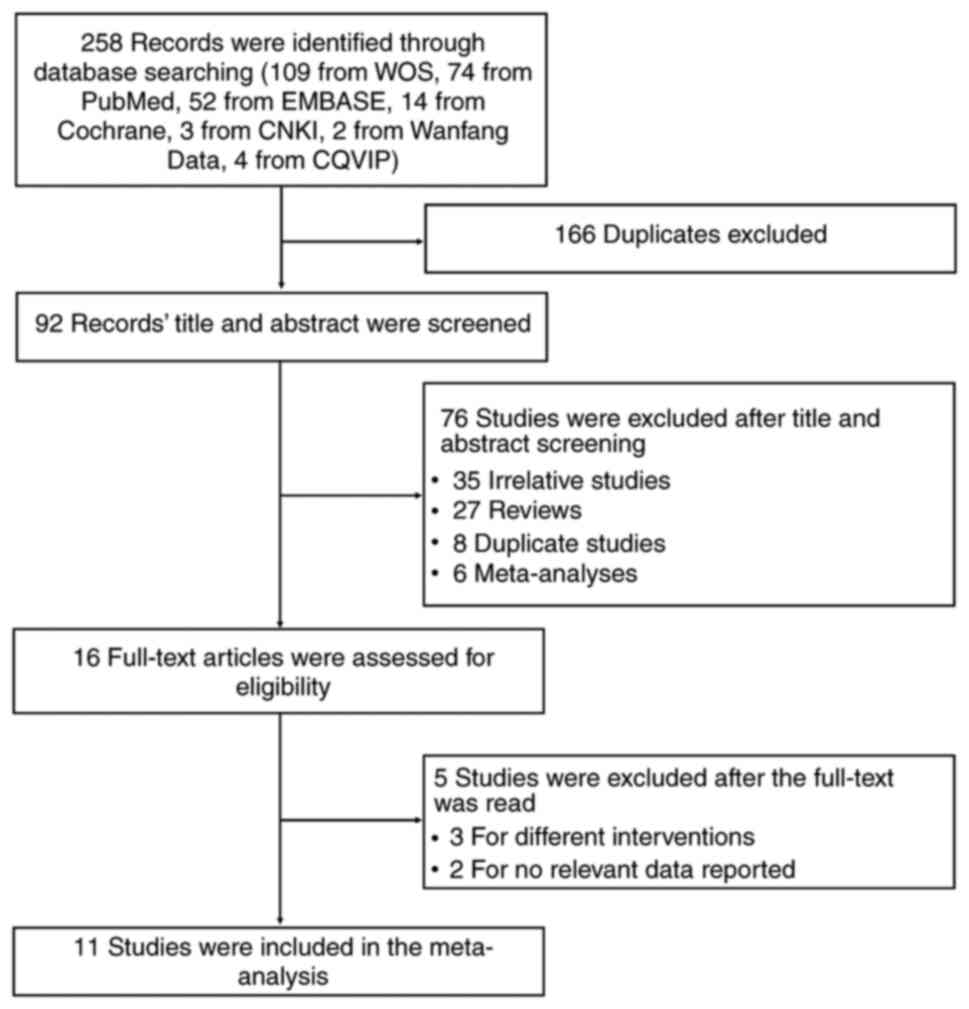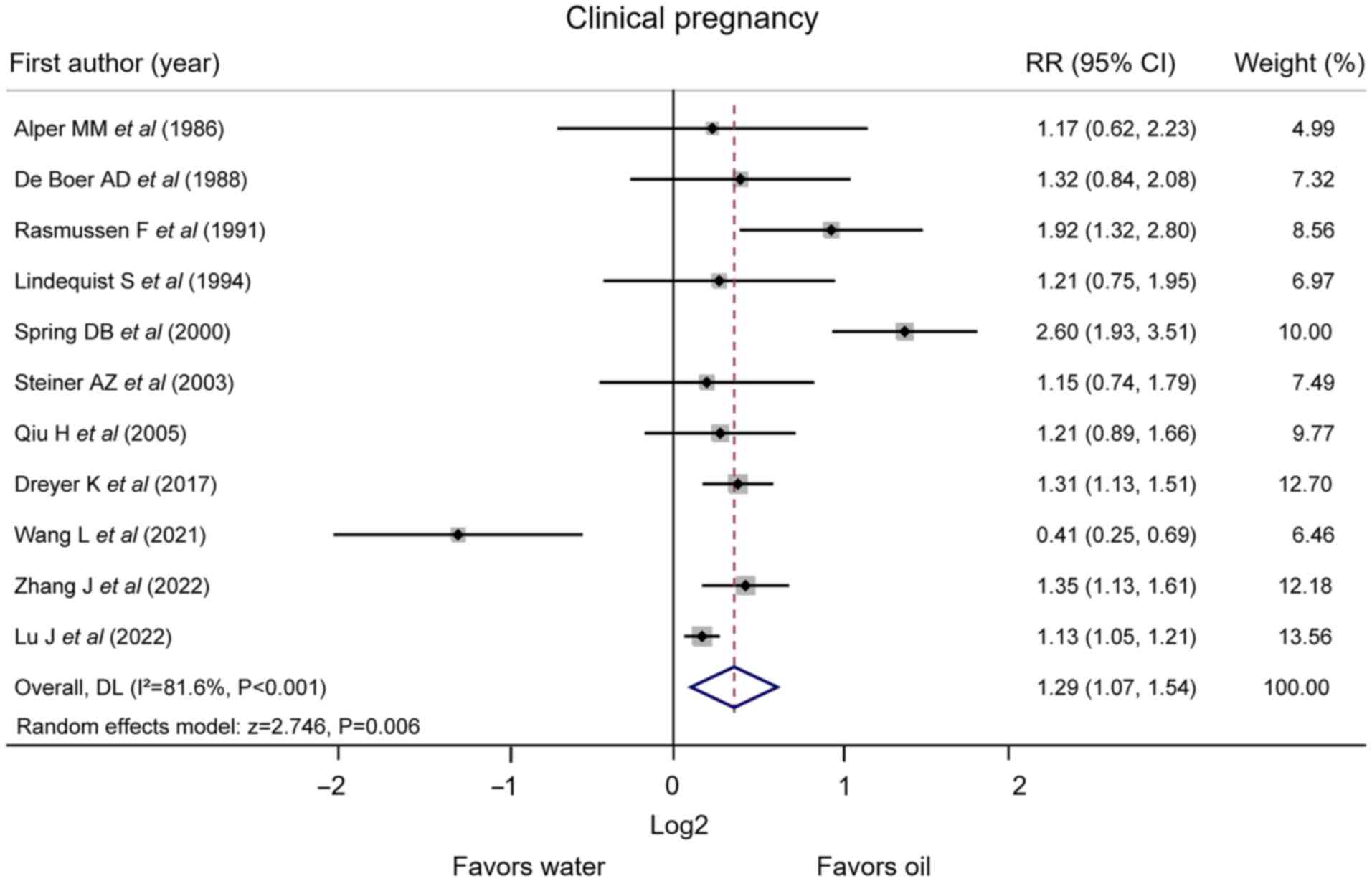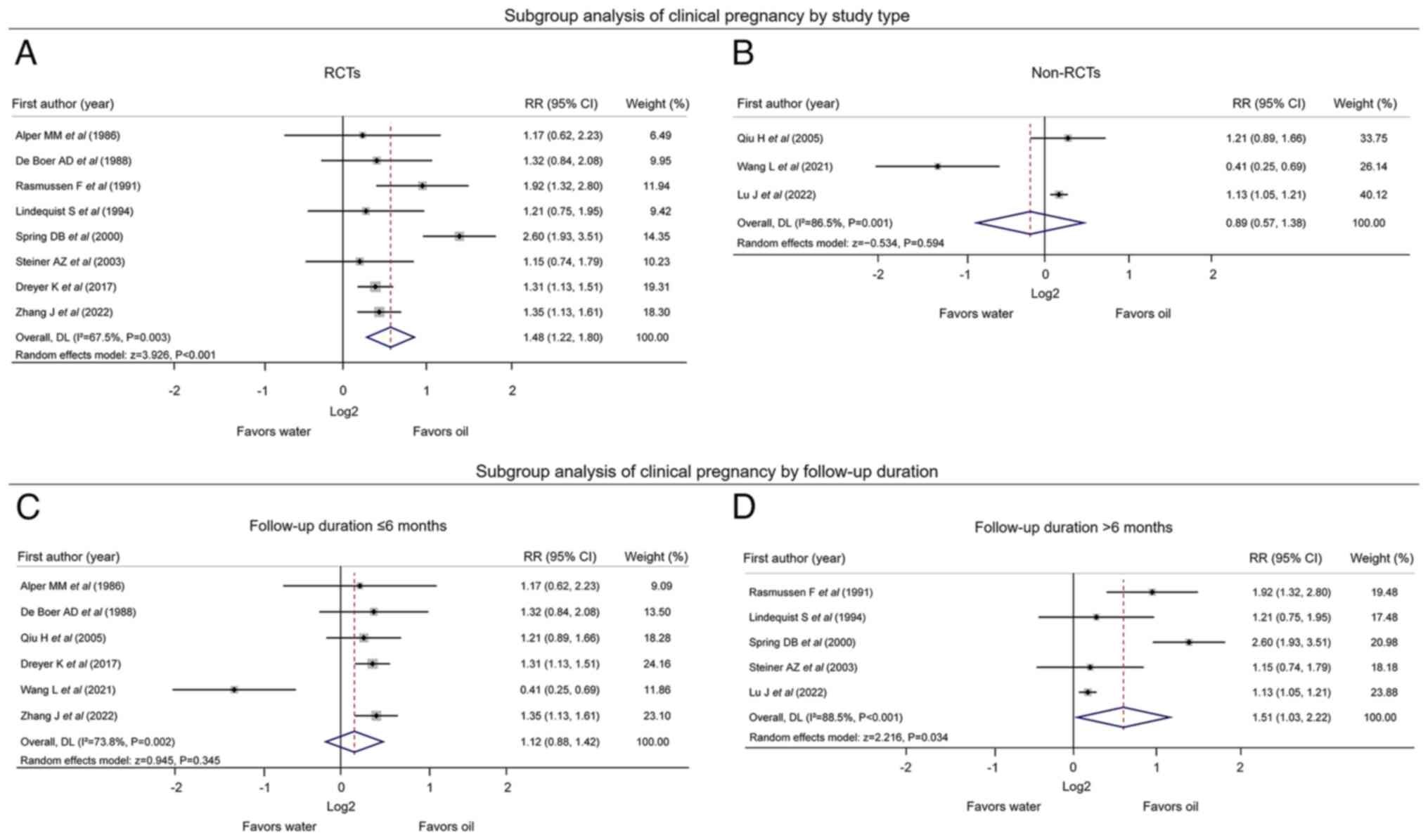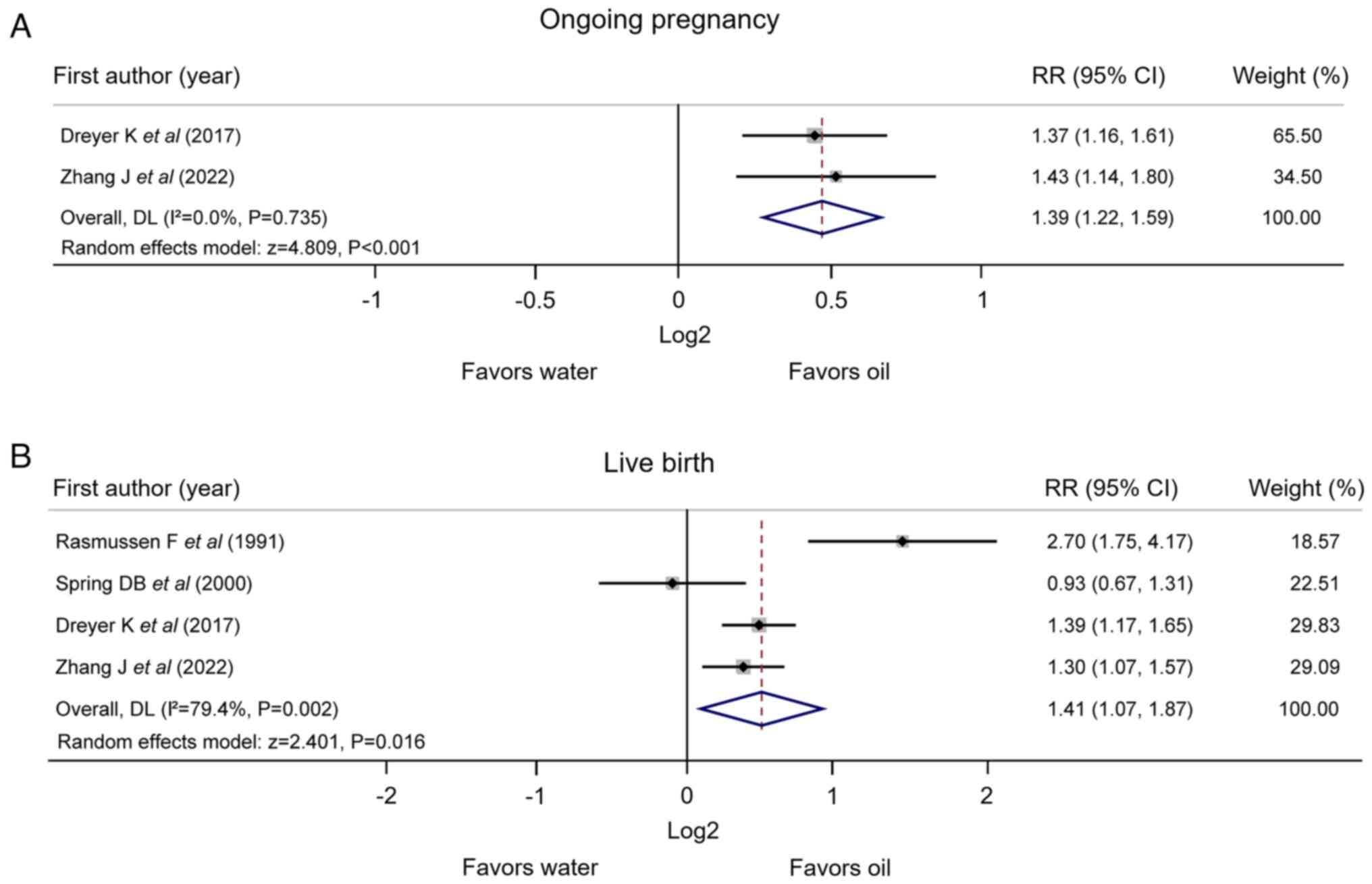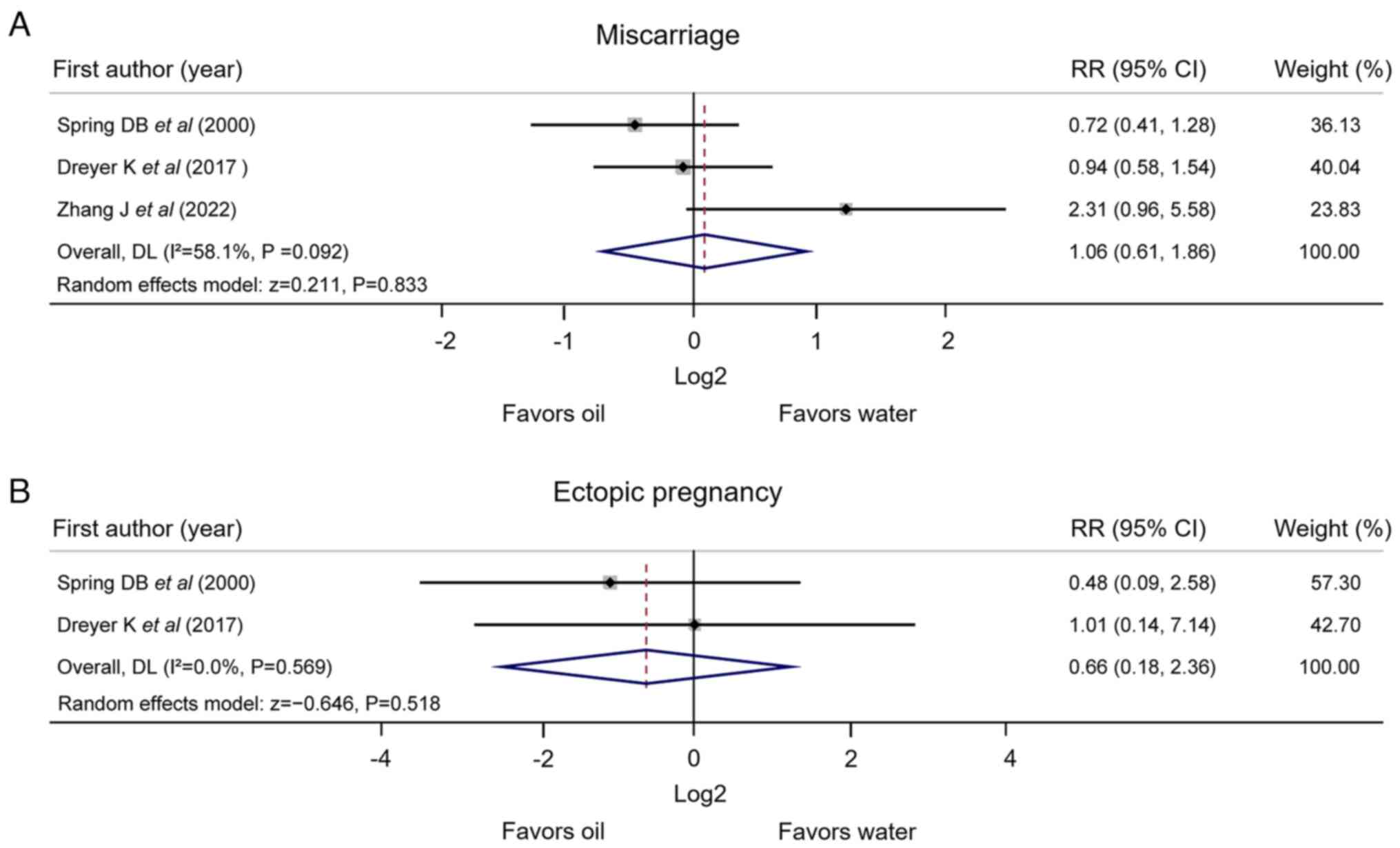Comparison of fertility outcomes between oil‑based
and water‑based contrast media during hysterosalpingography: A meta‑analysis
- Authors:
- Published online on: August 3, 2023 https://doi.org/10.3892/etm.2023.12148
- Article Number: 449
-
Copyright: © Chen et al. This is an open access article distributed under the terms of Creative Commons Attribution License.
Abstract
Introduction
Infertility is estimated to affect ~186 million individuals worldwide with a prevalence of 9-13% among women, which results in various social, psychological and economic issues (1-4). In general, numerous factors are responsible for female infertility, and fallopian tube obstruction is an important cause, accounting for ~35% of anatomical factor-induced infertility (5,6). Hysterosalpingography (HSG) is a common and valuable X-ray test for the uterus and fallopian tubes that assists in checking the patency of the fallopian tubes, the site of obstruction and the morphology of the uterine cavity (7,8). Beyond the diagnostic value, HSG also has a potential therapeutic implication for infertile female patients, since contrast medium is injected to flush the uterus and fallopian tubes of the patient, which improves the tubal patency and is beneficial for pregnancy (9,10).
Oil-based and water-based contrast media are two options for HSG. The oil-based contrast medium has a high viscosity, which enhances the flushing and dilation of the fallopian tubes, while the water-based contrast medium has a low viscosity and is absorbed quickly with a short stay in the pelvic cavity, which places a minimal influence on the patients (11). A number of previous studies have explored the effect of these two contrast media during HSG on improving fertility, and hypothesized that an oil-based contrast medium may be superior to a water-based contrast medium; however, the improved fertility-enhancing effect of oil-based contrast medium has not been widely accepted yet (9,12-24). For example, one randomized controlled trial (RCT), including patients with primary and secondary infertility, has highlighted that the oil-based contrast medium for HSG increases the ongoing pregnancy rate, number of clinical pregnancies and number of live births, as well as reduces the time to pregnancy compared with the water-based contrast medium (23). Another non-RCT study has indicated that the pregnancy rate is increased using the water-based contrast medium compared with the oil-based contrast medium in patients receiving HSG (22); however, this opposing finding may be due to the study having only enrolled patients with secondary infertility. Another study reported that the cumulative pregnancy rate is not influenced by using oil-based or water-based contrast medium in patients receiving HSG with primary or secondary infertility (19). A few previous meta-analyses have explored the optimal contrast medium for improving pregnancy in patients receiving HSG (25,26). However, these two meta-analyses used only RCTs and omitted the influence of non-RCTs. Additionally, some updated clinical studies regarding the fertility-enhancing effect in patients receiving HSG should be taken into account (23,24). Apart from the aforementioned study, a recently published meta-analysis also concluded that an oil-based contrast medium exhibits an improved fertility-enhancing effect compared with a water-based contrast medium in patients receiving HSG (27). However, all studies used in this meta-analysis were RCTs, thereby not taking into account the effect of non-RCTs. In addition, whether the fertility-enhancing effect of oil-based and water-based contrast media would be affected by the follow-up duration was not reported. Furthermore, only 4,739 patients were included in this meta-analysis, and a large-scale meta-analysis is required to improve the statistical power (27).
Therefore, the present meta-analysis comprehensively screened both RCTs and non-RCTs and slightly increased the number of patients with the aim of comparing the fertility-enhancing effect between the oil-based and water-based contrast media in patients receiving HSG.
Materials and methods
Search strategy
The present meta-analysis was conducted according to the Preferred Reporting Items for Systematic Review and Meta-Analysis guidelines (28). Studies that assessed the fertility enhancement between oil-based and water-based contrast media during HSG were screened in Web of Science (WOS) (https://clarivate.com/products/webofscience/), PubMed (https://pubmed.ncbi.nlm.nih.gov/), Excerpta Medica Database (EMBASE) (https://elh.nhs.wales/databases/databases/embase-excerpta-medica1/), Cochrane (https://www.cochranelibrary.com/), China National Knowledge Infrastructure (CNKI) (https://en.cnki.com.cn/), Wanfang Data (https://www.wanfangdata.com.cn/index.html) and China Science and Technology Journal Database (CQVIP; http://csi1.cqvip.com/productor/pro_zk.shtml) up to November 10, 2022 and there was no cut off for studies published earlier than any given year. The following medical subject headings and keywords were used for study searching: ‘Hysterosalpingography’, ‘HSG’, ‘hysterosalpingo contrast sonography’, ‘tubal patency test’, ‘laparoscopy’, ‘oil’, ‘ethiodol’, ‘lipiodol’, ‘poppy’, ‘water’, ‘iotrolan’, ‘iodipamide’, ‘iohexol’, ‘diatrizoate’ and ‘aqueous’. Additionally, the references of the included studies were also screened as aforementioned.
Study selection
Two researchers worked independently to complete the study screening. First, the studies were screened based on a previously designed information extraction form (25). Second, the title and the abstract were evaluated according to the inclusion and exclusion criteria described later. Third, the studies considered acceptable for inclusion were downloaded, and the full texts were read. Next, the data of the included studies were extracted, and their references were also examined as aforementioned. A cross-discussion or consultation with a 3rd investigator was held if there was a disagreement.
The inclusion criteria were as follows: i) RCT or non-RCT study (such as a cohort study or case-control study); ii) patients ≥18 years old; iii) patients underwent HSG with oil-based or water-based contrast medium; and iv) studies had ≥1 outcome concerned (including clinical pregnancy, ongoing pregnancy, live birth, miscarriage, or ectopic pregnancy) in the present study. The exclusion criteria were as follows: i) Other study types (such as a systematic review or meta-analysis); ii) duplicated study; and iii) incomplete or inconsistent data.
Data extraction
Two researchers worked independently to complete the data extraction. The extracted data contained the names of the authors, publication year, study type, study location, sample size, follow-up duration, method of tube flushing, contrast medium and outcome (clinical pregnancy, ongoing pregnancy, live birth, miscarriage or ectopic pregnancy). A cross-discussion or consultation with a 3rd investigator was held if there was a disagreement.
Quality assessment
The bias risk of RCTs was evaluated using the Cochrane Collaboration risk of bias tool, and involved selection, performance, detection, attrition and reporting bias amongst others (29). The bias risk of non-RCTs was evaluated using the Newcastle-Ottawa Scale criteria, and involved selection, comparability and outcome. A total score #x003C;4 was considered as high risk of bias; the total score ranging 4-6 was considered as moderate risk of bias; the total score ranging from 7-9 was considered as low risk of bias (30).
Statistical analysis
Stata software (version 14.0; StataCorp LP) was used for statistical analysis. Relative risks (RRs) and 95% confidence intervals (CIs) were presented for outcome assessment. Since none of the studies selected for this analysis have any relation with each other, the random effects model was utilized for all analyses regardless of the I2 value or P-value. It should be mentioned that I2 ≤50.0% and P≥0.10 referred to low heterogeneity. I2 >50% and P#x003C;0.01 referred to high heterogeneity. Publication bias was analyzed using Egger's and Begg's tests. Sensitivity analysis was carried out for the evaluation of data robustness and stability. Briefly, the RR and 95% CI calculations were performed again after sequentially omitting each study, then the results were compared with the previous data analysis and no statistically significant changes were considered to indicate low sensitivity to any study omission and robust results. P#x003C;0.05 was considered to indicate a statistically significant difference.
Results
Study screening procedure
Initially, 258 records were identified through database screening, including 109 records from WOS, 74 records from PubMed, 52 records from EMBASE, 14 records from Cochrane, 3 records from CNKI, 2 records from Wanfang Data and 4 records from CQVIP. Subsequently, 166 duplicates were excluded, and the remaining 92 records were screened by title and abstract. Subsequently, 76 records were excluded, including 35 irrelevant studies, 27 reviews, 8 duplicated studies and 6 meta-analyses. The remaining 16 full-text articles were then assessed for eligibility, during which 5 records were further excluded after the full-text was read, including 3 records for different interventions and 2 records for lacking relevant data. Finally, 11 studies were selected to be included in the present meta-analysis (Fig. 1).
Features of the included studies
The screened studies included eight RCTs (14-19,21,23) and three non-RCTs (20,22,24). Regarding the locations of the studies, the eight RCTs were conducted in USA, The Netherlands, Denmark and China, whereas the three non-RCTs were all conducted in China. The publication year of the selected studies ranged from 1986 to 2022; specifically, four studies were published before 2000, including Alper et al (14), de Boer et al (15), Rasmussen et al (16) and Lindequist et al (17); three studies were published between 2000 and 2010, including Spring et al (18), Steiner et al (19) and Qiu (20); and four studies were published after 2010, including Dreyer et al (21), Wang et al (22), Zhang et al (23) and Lu et al (24). A total of 5,292 patients were included in the present study, including 2,462 patients receiving oil-based contrast medium and 2,830 patients receiving water-based contrast medium during HSG. The majority of the studies included patients with primary and patients with secondary infertility; however, this information was unclear in two of the studies, and one study included only patients with secondary infertility. Regarding endometriosis, six studies did not report this information and three studies excluded patients with endometriosis; however, 24.8 and 18.6% of patients had a history of endometriosis in the other two studies. The specific features of the included studies are listed in Table I.
Quality assessments
Regarding selection bias, 5 RCTs were ranked as low risk of random sequence generation; thus, 62.5% (5/8) of the RCTs presented sufficient methods of random sequence generation. Meanwhile, 1 RCT was ranked as low risk of allocation concealment; thus,12.5% (1/8) of the studies disclosed adequate methods of allocation concealment. Since blind trials were impossible owing to the nature of the interventions, the risk of performance bias was scored as unclear. Considering that the fertility outcome was objective, a non-blinded design would not influence the outcome assessment; thus, the risk of detection bias was low in all studies. There were three RCTs at high risk of allocation concealment (19), incomplete outcome data (14) and other sources of bias (18) (Table II). In the three non-RCTs, the total score of the assessment of the risk of bias ranged from 7 to 9, which indicated a low risk of bias (Table III). Briefly, Qiu (20) lacked a definition for the controls and an adequate follow-up, resulting in a total score of 7. Wang et al (22) had a score of 1 for the risk of comparability owing to a lack of control for confounders, resulting in a total score of 8. Lu et al (24) had reduced bias compared with other two non-RCTs with a total score of 9.
Clinical pregnancy
All 11 studies reported clinical pregnancy. The pooled analysis revealed that the oil-based contrast medium increased the rate of clinical pregnancy compared with the water-based contrast medium [RR (95% CI), 1.29 (1.07, 1.54); P=0.006]. Heterogeneity existed among the studies (I2=81.6%; P#x003C;0.001; Fig. 2).
Subgroup analyses were carried out based on the study type. The pooled analysis of the eight RCTs revealed that the rate of clinical pregnancy was increased following the use of oil-based contrast medium compared with water-based contrast medium during HSG [RR (95% CI), 1.48 (1.22, 1.80); P#x003C;0.001]; heterogeneity existed among these studies (I2=67.5%; P=0.003) (Fig. 3A). Pooled analysis of the three non-RCTs suggested that the rate of clinical pregnancy was not different between patients receiving oil-based contrast medium and patients receiving water-based contrast medium for HSG [RR (95% CI), 0.89 (0.57, 1.38); P=0.594]; there was heterogeneity among these studies (I2=86.5%; P=0.001) (Fig. 3B). The pooled analysis of six studies with a follow-up duration ≤6 months revealed that the rate of clinical pregnancy was not affected by using oil-based or water-based contrast medium [RR (95% CI), 1.12 (0.88, 1.42); P=0.345]; heterogeneity existed among these studies (I2=73.8%; P=0.002) (Fig. 3C). Pooled analysis of five studies with a follow-up duration >6 months indicated that the rate of clinical pregnancy was increased using oil-based contrast medium compared with water-based contrast medium during HSG [RR (95% CI), 1.51 (1.03, 2.22); P=0.034]; heterogeneity existed among the studies (I2=88.5%; P#x003C;0.001) (Fig. 3D).
Ongoing pregnancy and live birth
There were two studies that reported ongoing pregnancy. The pooled analysis suggested that the rate of ongoing pregnancy was enhanced by the oil-based contrast medium compared with the water-based contrast medium during HSG [RR (95% CI), 1.39 (1.22, 1.59); P#x003C;0.001]; heterogeneity did not exist between the two studies (I2=0.0%; P=0.735) (Fig. 4A). In addition, four studies reported live birth, and the pooled analysis indicated that the rate of live birth was increased using oil-based contrast medium compared with water-based contrast medium [RR (95% CI), 1.41 (1.07, 1.87); P=0.016]; there was heterogeneity among the studies (I2=79.4%; P=0.002; Fig. 4B).
Miscarriage and ectopic pregnancy
There were three studies that reported miscarriage; however, the pooled analysis revealed that the rate of miscarriage was not affected by using oil-based or water-based contrast medium [RR (95% CI), 1.06 (0.61, 1.86); P=0.833]; there was no heterogeneity among the studies (I2=58.1%; P=0.092) (Fig. 5A). Furthermore, two studies reported ectopic pregnancy. The pooled analysis revealed that the rate of ectopic pregnancy was not affected by using oil-based or water-based contrast medium [RR (95% CI), 0.66 (0.18, 2.36); P=0.518]; there was no heterogeneity between the two studies (I2=0.0%; P=0.569) (Fig. 5B).
Publication bias and sensitivity analysis
Begg's and Egger's tests were carried out to estimate the potential publication bias, and the results suggested that no publication bias for clinical pregnancy, ongoing pregnancy, live birth, miscarriage and ectopic pregnancy existed (all P>0.05) (Table IV). In addition, sensitivity analysis was conducted, and it was demonstrated that omitting Dreyer et al (21) or Zhang et al (23) would affect the RR of the rate of live birth. Furthermore, the RR of clinical pregnancy, ongoing pregnancy, miscarriage and ectopic pregnancy did not change by omitting any single study, which indicated the stability of the present meta-analysis (Table V).
Discussion
The oil-based contrast medium has the benefit of increasing the rate of clinical pregnancy in patients receiving HSG; however, it has not been widely accepted and incorporated into clinical practice (14-24). For example, a previous study demonstrated that the clinical pregnancy rate was unchanged between patients receiving oil-based and water-based contrast media for HSG (14); however, this study did not indicate the infertility status (primary or secondary) of the patients. Another study reported that the use of oil-based contrast medium enhances clinical pregnancy compared with the water-based contrast medium during HSG in patients with primary infertility as well as in patients with secondary infertility (16). However, a recent study demonstrated that the water-based contrast medium improves the pregnancy rate compared with the oil-based contrast medium in patients with secondary infertility; this opposing finding may be attributable to the fact that all included patients had secondary infertility (22). The present meta-analysis reviewed 11 studies (including 8 RCTs and 3 non-RCTs), and revealed that the rate of clinical pregnancy was increased by using an oil-based contrast medium compared with a water-based contrast medium in patients receiving HSG; in addition, this finding was further confirmed in the subgroup analysis conducted in RCTs and studies with a follow-up duration >6 months. The potential reasons for this outcome could be as follows: i) The oil-based contrast medium regulates the dendritic cells and regulatory T cell profiles and it could be incorporated by dendritic cells, thus altering the immune environment in the peritoneal cavity, which further improves the fertility (31); ii) the slow absorption speed of the oil-based contrast medium enhances the suppression of macrophage phagocytosis and adherence, which further reduces sperm phagocytosis and increases clinical pregnancy (32); and iii) the oil-based contrast medium removes mucus plugs from the fallopian tubes, which improves tubal patency and is beneficial for clinical pregnancy (33-35). The oil-based contrast medium increased rate of clinical pregnancy compared with the water-based contrast medium in studies with a follow-up duration >6 months, which indicated that the pregnancy-enhancing effect of the oil-based contrast medium was improved over 6 months. Notably, heterogeneity in the rate of clinical pregnancy existed among the 11 studies analyzed. Although sensitivity analysis disclosed that no single study affected the pooled analysis of clinical pregnancy, further studies are required to verify these findings.
Apart from clinical pregnancy, the present meta-analysis also explored the efficacy of using an oil-based or a water-based contrast medium for improving ongoing pregnancy and live birth in patients receiving HSG. It was revealed that the rates of ongoing pregnancy and live birth were enhanced using an oil-based contrast medium compared with a water-based contrast medium in patients receiving HSG. It can be speculated that the oil-based contrast medium may be helpful for enhancing the receptivity of the endometrium, which is beneficial for embryo development and implantation (34,36,37), ultimately leading to the improvement of ongoing pregnancy and live birth. However, heterogeneity in live birth rates existed among the four studies analyzed, and sensitivity analysis indicated that after omitting Dreyer et al (21) or Zhang et al (23), the results of live birth would be affected. However, considering the number of studies that reported ongoing pregnancy and live birth were relatively few compared with the total number of studies analyzed, the reliability and generalization of these findings should be verified by further large-scale studies.
Miscarriage and ectopic pregnancy are two major concerns in pregnant patients, and these two issues may occur after HSG (18,21,23,38,39). The present study revealed that miscarriage and ectopic pregnancy did not differ after HSG with the oil-based or water-based contrast medium. The potential reason behind this may be that the major causes of miscarriage and ectopic pregnancy are chromosomal abnormalities, uterus abnormalities and hormonal problems, rather than the administration of contrast media (38,39). Thus, miscarriage and ectopic pregnancy were not affected by using oil-based or water-based contrast medium during HSG.
A recently published meta-analysis has demonstrated that using an oil-based contrast medium improves the pregnancy and live birth rates compared with a water-based contrast medium, whereas miscarriage and ectopic pregnancy are not affected by either an oil-based or a water-based contrast medium in patients receiving HSG (27). The present meta-analysis slightly increased the number of patients and screened both RCTs and non-RCTs, aiming to provide a comprehensive view of the fertility-enhancing effect of oil-based and water-based contrast media during HSG. In accordance with the aforementioned meta-analysis (27), it was also revealed in the present study that the fertility-enhancing effect was increased using an oil-based contrast medium compared with a water-based contrast medium during HSG, whereas miscarriage and ectopic pregnancy remained unchanged between the two contrast media. The present meta-analysis also revealed that in studies with a follow-up duration >6 months, the fertility-enhancing effect was increased using an oil-based contrast medium compared with a water-based contrast medium during HSG.
The majority of the studies used in the present meta-analysis did not include information on endometriosis. However, two of the studies reported 24.8% (19) and 18.6% (24) of patients with a history of endometriosis. In addition, three studies indicated that patients with fallopian tube disease, including endometriosis, were excluded (21-23). Furthermore, the majority of the studies contained patients with primary and secondary infertility (15-19,21,23,24); however, two studies did not clearly report whether the patients had primary or secondary infertility (14,20), and one study included only patients with secondary infertility (22). Although whether patients have primary or secondary infertility may unavoidably affect the results of the present meta-analysis, the majority of the included studies did not distinguish patients based on the type of infertility. Thus, the present study could not analyze the results based on whether the patients had primary or secondary infertility, and further studies that focus on the specific type of patients should be conducted.
A number of limitations of the present study should be noted: i) The number of studies that reported ongoing pregnancy and live birth was small, thus, more large-scale studies are required to validate these findings; ii) sensitivity analysis revealed that omitting Dreyer et al (21) or Zhang et al (23) would affect the pooled analysis finding of rates of live births; thus, more updated studies are required to validate this finding; iii) there were three studies at high risk of selection, attrition or other bias, which may interfere with the results; and iv) the findings of the present meta-analysis require further verification with real-world clinical-setting studies.
The present meta-analysis concluded that using an oil-based contrast medium increases the rates of clinical pregnancy, ongoing pregnancy and live birth compared with a water-based contrast medium in patients receiving HSG, indicating the oil-based contrast medium for HSG may exert a superior fertility-enhancing effect.
Acknowledgements
Not applicable.
Funding
Funding: No funding was received.
Availability of data and materials
The datasets used and/or analyzed during the current study are available from the corresponding author on reasonable request.
Authors' contributions
JL contributed to the study conception and design. JC and SL performed data acquisition, analysis and interpretation. JL and JC confirm the authenticity of all raw data. All authors have read and approved the final version of the manuscript.
Ethics approval and consent to participate
Not applicable.
Patient consent for publication
Not applicable.
Competing interests
The authors declare that they have no competing interests.
References
|
Inhorn MC and Patrizio P: Infertility around the globe: New thinking on gender, reproductive technologies and global movements in the 21st century. Hum Reprod Update. 21:411–426. 2015.PubMed/NCBI View Article : Google Scholar | |
|
Boivin J, Bunting L, Collins JA and Nygren KG: International estimates of infertility prevalence and treatment-seeking: Potential need and demand for infertility medical care. Hum Reprod. 22:1506–1512. 2007.PubMed/NCBI View Article : Google Scholar | |
|
Datta J, Palmer MJ, Tanton C, Gibson LJ, Jones KG, Macdowall W, Glasier A, Sonnenberg P, Field N, Mercer CH, et al: Prevalence of infertility and help seeking among 15 000 women and men. Hum Reprod. 31:2108–2118. 2016.PubMed/NCBI View Article : Google Scholar | |
|
Carson SA and Kallen AN: Diagnosis and management of infertility: A review. JAMA. 326:65–76. 2021.PubMed/NCBI View Article : Google Scholar | |
|
Abrao MS, Muzii L and Marana R: Anatomical causes of female infertility and their management. Int J Gynaecol Obstet. 123 (Suppl 2):S18–S24. 2013.PubMed/NCBI View Article : Google Scholar | |
|
Grigovich M, Kacharia VS, Bharwani N, Hemingway A, Mijatovic V and Rodgers SK: Evaluating fallopian tube patency: What the radiologist needs to know. Radiographics. 41:1876–18961. 2021.PubMed/NCBI View Article : Google Scholar | |
|
Baramki TA: Hysterosalpingography. Fertil Steril. 83:1595–1606. 2005.PubMed/NCBI View Article : Google Scholar | |
|
Zafarani F, Ghaffari F, Ahmadi F, Soleimani Mehranjani M and Shahrzad G: Hysterosalpingography in the assessment of proximal tubal pathology: A review of congenital and acquired abnormalities. Br J Radiol. 94(20201386)2021.PubMed/NCBI View Article : Google Scholar | |
|
Li H, Ren Y, Yan J, Huang M, Zheng B, Luo X, Huang S and Cai S: Fertility outcome and safety of ethiodized poppy seed oil for hysterosalpingography in 1,053 infertile patients: A real-world study. Front Med (Lausanne). 9(804494)2022.PubMed/NCBI View Article : Google Scholar | |
|
Roest I, Hajiyavand AM, Bongers MY, Mijatovic V, Mol BWJ, Koks CAM and Dearn KD: What is the fertility-enhancing effect of tubal flushing? A hypothesis article. J Obstet Gynaecol. 42:1619–1625. 2022.PubMed/NCBI View Article : Google Scholar | |
|
Burks HR and Hansen KR: Oil or water-based contrast for hysterosalpingography? Fertil Steril. 114:75–76. 2020.PubMed/NCBI View Article : Google Scholar | |
|
Liang G, Zhu Q, He X, Wang X, Jiang L, Zhu C, Xie L, Qian Z and Zhang J: Effects of oil-soluble versus water-soluble contrast media at hysterosalpingography on pregnancy outcomes in women with a low risk of tubal disease: Study protocol for a randomised controlled trial. BMJ Open. 10(e039166)2020.PubMed/NCBI View Article : Google Scholar | |
|
van Rijswijk J, van Welie N, Dreyer K, Pham CT, Verhoeve HR, Hoek A, de Bruin JP, Nap AW, van Hooff MHA, Goddijn M, et al: Tubal flushing with oil-based or water-based contrast at hysterosalpingography for infertility: Long-term reproductive outcomes of a randomized trial. Fertil Steril. 114:155–162. 2020.PubMed/NCBI View Article : Google Scholar | |
|
Alper MM, Garner PR, Spence JE and Quarrington AM: Pregnancy rates after hysterosalpingography with oil- and water-soluble contrast media. Obstet Gynecol. 68:6–9. 1986.PubMed/NCBI | |
|
de Boer AD, Vemer HM, Willemsen WN and Sanders FB: Oil or aqueous contrast media for hysterosalpingography: A prospective, randomized, clinical study. Eur J Obstet Gynecol Reprod Biol. 28:65–68. 1988.PubMed/NCBI View Article : Google Scholar | |
|
Rasmussen F, Lindequist S, Larsen C and Justesen P: Therapeutic effect of hysterosalpingography: Oil-versus water-soluble contrast media-a randomized prospective study. Radiology. 179:75–78. 1991.PubMed/NCBI View Article : Google Scholar | |
|
Lindequist S, Rasmussen F and Larsen C: Use of iotrolan versus ethiodized poppy-seed oil in hysterosalpingography. Radiology. 191:513–517. 1994.PubMed/NCBI View Article : Google Scholar | |
|
Spring DB, Barkan HE and Pruyn SC: Potential therapeutic effects of contrast materials in hysterosalpingography: A prospective randomized clinical trial. Kaiser permanente infertility work group. Radiology. 214:53–57. 2000.PubMed/NCBI View Article : Google Scholar | |
|
Steiner AZ, Meyer WR, Clark RL and Hartmann KE: Oil-soluble contrast during hysterosalpingography in women with proven tubal patency. Obstet Gynecol. 101:109–113. 2003.PubMed/NCBI View Article : Google Scholar | |
|
Qiu HX: Clinical observation of 283 cases of hysterosalpingography using nonionic contrast media. Chongqing Med J. 34:796–798. 2005. | |
|
Dreyer K, van Rijswijk J, Mijatovic V, Goddijn M, Verhoeve HR, van Rooij IAJ, Hoek A, Bourdrez P, Nap AW, Rijnsaardt-Lukassen HGM, et al: Oil-based or water-based contrast for hysterosalpingography in infertile women. N Engl J Med. 376:2043–2052. 2017.PubMed/NCBI View Article : Google Scholar | |
|
Wang LY, Du WF and Zhang QH: Explore the clinical effect of iodized water and Lipiodol in the diagnosis and treatment of secondary infertility in hysterosalpingography. J Nongken Med. 43:29–31. 2021. | |
|
Zhang J, Lan W, Wang Y, Chen K, Zhang G, Yang W, Chen H, Xu W, Ma J, Qin W, et al: Ethiodized poppyseed oil-based contrast medium is superior to water-based contrast medium during hysterosalpingography regarding image quality improvement and fertility enhancement: A multicentric, randomized and controlled trial. EClinicalMedicine. 46(101363)2022.PubMed/NCBI View Article : Google Scholar | |
|
Lu J, Qi D and Xu W: Fertility-enhancing effect of oil-based contrast agents during hysterosalpingography and the variation of this effect within a 3-year follow-up period in infertile patients. Front Med (Lausanne). 9(948945)2022.PubMed/NCBI View Article : Google Scholar | |
|
Wang R, van Welie N, van Rijswijk J, Johnson NP, Norman RJ, Dreyer K, Mijatovic V and Mol BW: Effectiveness on fertility outcome of tubal flushing with different contrast media: Systematic review and network meta-analysis. Ultrasound Obstet Gynecol. 54:172–181. 2019.PubMed/NCBI View Article : Google Scholar | |
|
Fang F, Bai Y, Zhang Y and Faramand A: Oil-based versus water-based contrast for hysterosalpingography in infertile women: A systematic review and meta-analysis of randomized controlled trials. Fertil Steril. 110:153–160.e3. 2018.PubMed/NCBI View Article : Google Scholar | |
|
Tsui S and Sofy AA: A meta-analysis of fertility and adverse outcomes in oil- and water-based contrast for hysterosalpingography. Turk J Obstet Gynecol. 20:64–73. 2023.PubMed/NCBI View Article : Google Scholar | |
|
Moher D, Liberati A, Tetzlaff J and Altman DG: PRISMA Group. Preferred reporting items for systematic reviews and meta-analyses: The PRISMA statement. PLoS Med. 6(e1000097)2009.PubMed/NCBI View Article : Google Scholar | |
|
Lundh A and Gøtzsche PC: Recommendations by cochrane review groups for assessment of the risk of bias in studies. BMC Med Res Methodol. 8(22)2008.PubMed/NCBI View Article : Google Scholar | |
|
Wells GA, Shea B, O'Connell D, et al: The Newcastle-Ottawa Scale (NOS) for assessing the quality of nonrandomized studies in meta-analyses. The Ottawa Hospital. | |
|
Izumi G, Koga K, Takamura M, Bo W, Nagai M, Miyashita M, Harada M, Hirata T, Hirota Y, Yoshino O, et al: Oil-soluble contrast medium (OSCM) for hysterosalpingography modulates dendritic cell and regulatory T cell profiles in the peritoneal cavity: A possible mechanism by which OSCM enhances fertility. J Immunol. 198:4277–4284. 2017.PubMed/NCBI View Article : Google Scholar | |
|
Johnson JV, Montoya IA and Olive DL: Ethiodol oil contrast medium inhibits macrophage phagocytosis and adherence by altering membrane electronegativity and microviscosity. Fertil Steril. 58:511–517. 1992.PubMed/NCBI View Article : Google Scholar | |
|
van Welie N, Dreyer K, van Rijswijk J, Verhoeve HR, Goddijn M, Nap AW, Smeenk JMJ, Traas MAF, Rijnsaardt-Lukassen HGM, van Dongen AJCM, et al: Treatment effect of oil-based contrast is related to experienced pain at HSG: A post-hoc analysis of the randomised H2Oil study. Hum Reprod. 34:2391–2398. 2019.PubMed/NCBI View Article : Google Scholar | |
|
van Welie N, Rosielle K, Dreyer K, van Rijswijk J, Lambalk CB, van Geloven N, Mijatovic V, Mol BWJ and van Eekelen R: H2Oil Study Group. How long does the fertility-enhancing effect of hysterosalpingography with oil-based contrast last? Reprod Biomed Online. 41:1038–1044. 2020.PubMed/NCBI View Article : Google Scholar | |
|
Wang R, Watson A, Johnson N, Cheung K, Fitzgerald C, Mol BWJ and Mohiyiddeen L: Tubal flushing for subfertility. Cochrane Database Syst Rev. 10(CD003718)2020.PubMed/NCBI View Article : Google Scholar | |
|
Harris EA, Stephens KK and Winuthayanon W: Extracellular vesicles and the oviduct function. Int J Mol Sci. 21(8280)2020.PubMed/NCBI View Article : Google Scholar | |
|
Court KA, Dare AJ, Weston-Webb M, Hadden WE, Sim RG and Johnson NP: Establishment of lipiodol as a fertility treatment-prospective study of the complete innovative treatment data set. Aust N Z J Obstet Gynaecol. 54:13–19. 2014.PubMed/NCBI View Article : Google Scholar | |
|
Quenby S, Gallos ID, Dhillon-Smith RK, Podesek M, Stephenson MD, Fisher J, Brosens JJ, Brewin J, Ramhorst R, Lucas ES, et al: Miscarriage matters: The epidemiological, physical, psychological, and economic costs of early pregnancy loss. Lancet. 397:1658–1667. 2021.PubMed/NCBI View Article : Google Scholar | |
|
Tonick S and Conageski C: Ectopic pregnancy. Obstet Gynecol Clin North Am. 49:537–549. 2022.PubMed/NCBI View Article : Google Scholar |



